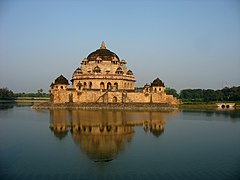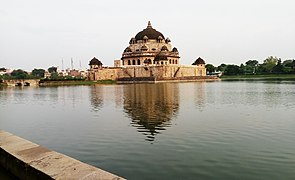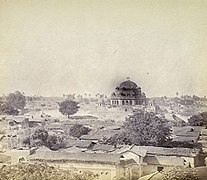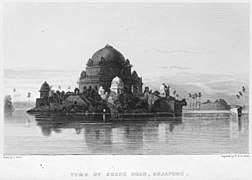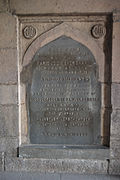Tomb of Sher Shah Suri
Template:Infobox Monument The tomb of Sher Shah Suri is in the Sasaram town of Bihar state, India. The tomb was built in memory of Emperor Sher Shah Suri, a Pathan from Bihar who defeated the Mughal Empire and founded the Suri Empire in northern India. He died in an accidental gunpowder explosion in the fort of Kalinjar on 10th day of Rabi' al-awwal, A.H. 952 or 13 May 1545 AD.[1][2]
Architecture[edit | edit source]
His tomb is an example of Indo-Islamic architecture, it was designed by the architect Mir Muhammad Aliwal Khan and built between 1540 and 1545,[3] this red sandstone mausoleum (122 ft high), which stands in the middle of an artificial lake, which is nearly square, is known as the second Taj Mahal of India. The tomb stands at the centre of the lake on a square stone plinth with domed kiosks, chhatris at each of its corners, further there are stone banks and stepped moorings on all sides of the plinth, which is connected to the mainland through a wide stone bridge. The main tomb is built on octagonal plan, topped by a dome, 22-metre in span and surrounded ornamental domed kiosks which were once covered in coloured glazed tile work. The lake around the tomb is seen as a development in the Afghan phase of Sultan architecture by the Sur Dynasty.[4]
The tomb was built during the lifetime of Sher Shah as well as the reign of his son Islam Shah. An inscription dates its completion to 16 August 1545, three months after the death of Sher Shah.[5][6]
Gallery[edit | edit source]
Current[edit | edit source]
Historic[edit | edit source]
Plaque, info , tablet[edit | edit source]
How to reach Sher Shah Tomb?[edit | edit source]
- Roadway: By road is easily accessible from any corner of Sasaram city. Rauja road and rauja Road No. 1 (Prabhakar road) are the main roads to reach here.
- Railway: Sasaram is a major railway station between Varanasi (Banaras) and Gaya. Sasaram can be easily reached from different states of the country by direct or by changing train from Deendayal Upadhyaya station (Mughal Sarai).
References[edit | edit source]
- ↑ Shershah Suri's Tomb, Sasaram - Ticketed Monument Archaeological Survey of India
- ↑ Kissling, H. J.; Barbour, N; Spuler, Bertold; Trimingham, J. S.; Bagley, F. R. C.; Braun, H.; Hartel, H. (1997). The Last Great Muslim Empires. BRILL. pp. 262–263. ISBN 90-04-02104-3. Retrieved 20 July 2011.
- ↑ Narayan Sanyal (2016). Abiswaraniya (Bengali). Kolkata: Dey's Publishing. p. 278. ISBN 978-81-295-2648-9.
- ↑ Habib, Irfan (2007). Medieval India the study of a civilization. National Book Trust, India. p. 228. ISBN 978-81-237-5255-6.
- ↑ Catherine B. Asher (1977). "The mausoleum of Sher Shah Suri". Artibus Asiae. Artibus Asiae Publishers. 39 (3/4): 273–298. doi:10.2307/3250169. JSTOR 3250169.
- ↑ "Sasaram". Institute of Oriental Culture, University of Tokyo. Retrieved 6 November 2018.
- Tomb of Sher Shah by R Chopra, Indo-Iranica Vol. 10 (2)


